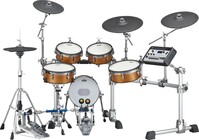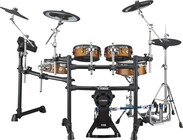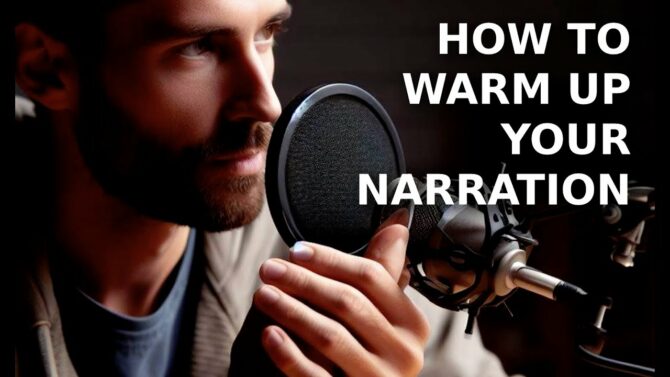One of your biggest challenges in House of Worship sound reinforcement Definition:
Definition:
Originally meant to electrically augment acoustic performances, but now means any public address system. See PA. is getting a great drum sound—but help is on the way.
I’m always asked how to set up drum mics, and how to control the level of what is the loudest instrument on the worship stage. After asking a few qualifying questions to determine the whys and the wherefores, I usually have some suggestions—because the problems are so common that the solutions always seem to be the same.
Drums Are Not Loud. Drummers Are!
Getting great sounds from drums isn’t just about the drums themselves sounding good—although that is crucial—but also about a drummer who knows how to tune, maintain, and play them. For starters, drums will sound better with new heads that are tuned correctly and musically (think intervals, like perfect fourths), and from which any rings and rattles have been reduced or eliminated.
There’s an old saying, “garbage in, garbage out” (GIGO for short) that applies to any instrument or voice. No microphone will ever make something bad sound better—all a really good mic does is to reproduce the bad sound as accurately as possible. Choosing the wrong mic (like one with an omni Definition:
Definition:
Short for Omnidirectional. See Omnidirectional. polar pattern Definition:
Definition:
A graphic representation illustrating in positional degrees the sensitivity or radiation of a microphone, speaker, or antenna. when you really want a cardioid Definition:
Definition:
A microphone's heart-shaped directional pickup pattern. pattern so you can isolate the sound being miked) can even make the sound worse. Get the source right, find the right spot to place the mic, and choose the right mic for the application.
I still marvel at how churches sometimes spend an inordinate amount of money to fix the wrong problem. For example, because the drums are loud, they think adding a plastic acrylic screen is the answer. But it’s only half of a solution! Surrounding the loudest of all instruments with a highly reflective surface is a recipe for disaster, because the screen reflects most of the sound that hits it—and what you really need is something that absorbs sound. It’s not too much of a stretch to say that the main benefit of an acrylic screen is that it’s a great place to affix material that absorbs sounds, like acoustic panels or foam.

A lot of churches also think electronic drums (like Yamaha's DTX Series, DTX10K-X pictured) are the answer, and they can indeed help keep levels under control (Fig. 1).
As a group, jazz drummers are often worth emulating. In a scenario like a piano/acoustic bass/drums trio, they have to play with finesse and control. Those same traits will help make for not just a better drummer, but a better service.
The Recipe for Great Drum Sounds
Let’s look at the ingredients which, when combined in the right proportion, guarantee a great drum experience.
A good set of drum(s), tuned and free from unwanted noise/ tones. Choose the instruments that match the room—think size and projection, and remember that smaller rooms want smaller drum sets. Smaller drums have less tension on the heads, so they’re not as loud. An alternative is tuning standard drums higher. Although there will be more tension on the heads, they’ll respond well to lighter touches (which, of course, requires a drummer who knows how to dial back the force). An inexpensive mahogany set, with smaller drum sizes, will tend to sound quieter than a maple set with regular-size drums. Portable kits aren’t only easier to lug around and set up, but can potentially be quieter than a full-size kit. Some “cocktail sets” are also quieter than standard drums (and let’s face it... a drummer who stands up looks cool anyway).
Find the location on the platform where the drums sound best. I don’t care where they look the most visually appealing, where do they sound best? Don’t underestimate this step! Move the drums to various places on stage, and take notes on what works best. Also, try isolating the cymbals with an acoustic panel, like the Clearsonic S2466X2 to keep cymbal sounds from spilling over into vocal mics (cymbals are loud enough as is). If you keep having the same problems but don’t change anything...well, you know what they say about the definition of insanity.
A drummer who knows about nuance. You need a drummer who knows how to play to a particular space, plays well with others, and understands the relationship of touch, dynamics Definition:
Definition:
In a musical performance, changes in overall volume levels, often accompanied by timbral changes. Example: Classical symphonic music has a wide dynamic range, while dance mixes have a much narrower dynamic range., and volume. Not all drummers are the same, and you may need to undergo a search to find someone who understands the unique needs involved with playing in Houses of Worship.
A sound operator who knows about microphones and mixing. However, that’s not enough: the person doing the mixing needs to make sure that everything serves the needs of the congregation, as well as the musicians.
Microphones: The Crucial Link
Typically, fewer microphones will almost always sound better than more microphones. If your sound system is mono Definition:
Definition:
Short for Monophonic. An audio program, recording, or hardware device/software routine that produces or processes a signal with only one channel., you can ditch the second overhead mic (unless you’re recording in stereo Definition:
Definition:
A two channel signal simulating a sound space, typically played through two speakers.). One condenser Definition:
Definition:
An archaic term for Capacitor. over the center of the kit will get the whole kit. This one microphone can provide the body of your drum sound. When using two overheads you can cover more area and pan Definition:
Definition:
Horizontal pivot of a camera or light, opposite of Tilt, or the placement of a sound element in stereo or surround sound. the kit in stereo. However, this can also introduce phase interactions, which affect the sound negatively if you aren’t paying attention.

One of the simplest solutions for drum miking is to buy a drum mic kit, like Shure’s DMK57-52 (Fig. 2). This includes a kick drum mic, and three Shure SM57 mics—about as close as you can come to an industry-standard drum mic.
If you want to get more involved in close miking, then a drum mic kit like the Audix DP5PLUS is a good choice—it includes 2 rack Definition:
Definition:
A frame for holding gear that meets an industry standard for enclosures. This specifies a 19 inch width, and a height that is some multiple of 1.75 inches. A rack frame can be open or enclosed, and has rails drilled with standardized screw holes for attaching rack equipment.. tom mics, 1 floor tom mic, 1 snare mic, kick mic, and a general-purpose ADX51 condenser mic.

For a high-end drum-miking kit, I’m a huge fan of the Earthworks DK7 (Fig. 3). This is a premium condenser mics collection with 4 cardioid mics designed for close miking toms and snare, 2 cardioid mics for overhead pickup Definition:
Definition:
1. Transducer attached to a musical instrument that converts mechanical vibrations into an electrical signal for recording or amplification 2. The part of a phonograph that translates mechanical motion from grooves into electrical signals for subsequent amplification., and 1 specially-engineered kick drum mic.
There is so little need to EQ anything with them that they’re almost magical. The gain and the tonal response stay consistent to the edges of the pattern, resulting in a very natural sound—you have to hear them to know what I’m talking about. They’re expensive, but are sometimes available on sale so keep an eye out for any deals. I’ve heard nothing better on drums (or pianos and choirs, for that matter).

If you need more kick, place a microphone with excellent low-frequency response Definition:
Definition:
The range of frequencies that an audio, video or data device can pass. in front of the head, or in a hole cut out in the head or right inside of the kick drum (Fig. 4). Move the mic to where it sounds the best before EQ’ing. I like condensers, while others prefer large-diaphragm Definition:
Definition:
The moving portion of a microphone that transforms sound waves into motion that can ultimately produce electrical waves. dynamic mics, but there are also special-purpose kick drum mics (as included in the various drum mic kits mentioned previously).
Two-microphone setup:
It’s surprising how well a simple, two-microphone setup works—a condenser mic for the overhead to pick up the kit, and a dedicated Definition:
Definition:
Designed or used to do a specific task or set of tasks. kick drum mic. I can play you a thousand records recorded this way. Or use two overheads in a spaced pair Definition:
Definition:
Spacing two microphones 3 to 10 feet apart to create a stereo image., or X-Y configuration.
Another way to use two microphones is one for the overhead, and one on the snare. When playing live, the kick is often loud enough that it won’t necessarily need a mic.
Three-microphone setup:
Perhaps you need to hear more of the snare. Typically, you’ll place a dynamic mic like the Shure SM57 1"-2" above the snare’s rim. Point it down to get more attack, or aim it toward the center for tone. Keep it out of the drummer’s way. Even moving the mic as little as an inch or two will give different tones and responses, depending on the mic’s type and polar pattern. Always move the mic to fix the tone before trying to do so with equalization. Also, consider using condenser mics on the drums for their faster transient response Definition:
Definition:
The ability for a piece of equipment to follow a fast-rising waveform, and reproduce it accurately. compared to moving-coil Definition:
Definition:
(slang) Inductor; its derivation is that most inductors are made up of coils of wire. (dynamic) microphones; the downside is needing phantom power Definition:
Definition:
A source of power for a microphone (usually condenser) that travels to the microphone over the microphone's cable. There are different voltage standards and requirements for different microphones, but the most common standard is 48 Volts. It derives its name because there is no visible power cable. from the mixing console Definition:
Definition:
A control surface for audio, video, or lighting control positioned like a desk. Also called, Mixer, Controller, Board, or (British) Desk. or preamp, and greater risk of damage if the mic gets hit by an over-enthusiastic drum stick.
Four-microphone setup:
This covers the entire kit 80% of the time. It could be two overheads (small or large-diaphragm condensers) in a spaced-pair (pay attention to horizontal and vertical planes so that the microphones are equidistant from the snare or the center of the drum kit), a coincident (X-Y) arrangement, or a variation on the “Glyn Johns” technique—a 3 or 4-mic drum miking setup used on countless records. You’ll be amazed at the results.

If you want to put a mic on every drum, go ahead, as long as you’ve taken the time to prevent phase anomalies from occurring. Use your EQ to limit the frequency Definition:
Definition:
A value, expressed in Hertz, that indicates how many cycles of a periodic signal occur in one second. ranges of the different drums and cymbals to only those drums (your snare mic doesn’t have a bass response low enough to pick up your kick). Use high-pass (low-cut) EQ on the snare, hi-hat, upper toms and overheads. You can mic toms closely, but try to make sure the mics are out of the way of errant stick hits (Fig. 5).
Try to keep reflections from hard surfaces (sheetrock, plastic, etc.) from entering into the mics. This will definitely smear the sound, and affect your sound negatively.
There’s not enough time or space to go deeper in this article about microphone choices, polar (pickup) patterns, equalization, dynamic processing (compression/gating), monitoring, and all the other ways to make miking sound even better—but if you start here, you will hear a difference.
Doug Gould is the CEO and Founder of Worship MD, a consulting firm that’s devoted to helping Houses of Worship train, equip, and unify their worship and technical teams. Visit the web site at worshipmd.com for news of upcoming workshops featuring Doug, as well as his blog and resource center.



















